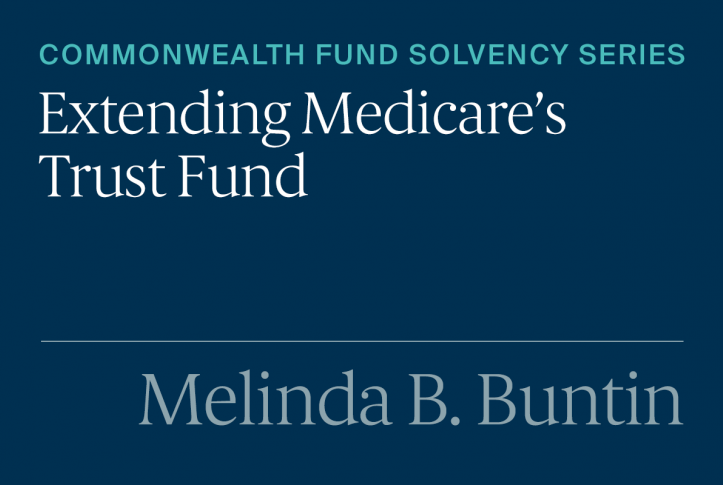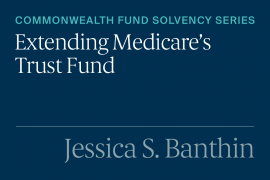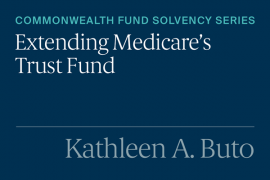The Medicare Hospital Insurance (HI) Trust Fund, which pays for Medicare beneficiaries’ hospital bills and other services, is projected to become insolvent in 2031. Without changes to expected spending or trust fund revenue, the trust fund will not have sufficient funds to cover the entire cost of beneficiaries’ health care. The HI trust fund is primarily funded through payroll taxes paid by employers and employees, with some additional income from interest as well as premiums paid by voluntary enrollees not automatically entitled to Medicare Part A. Will the trust fund solvency be extended by reducing the projected growth in expenditures, raising revenues, changes to the services covered by Medicare Part A, or a combination of these options
To stimulate policy discussions, the Commonwealth Fund asked a group of Medicare thought leaders with a variety of backgrounds and political affiliations to outline how they would extend the life of the trust fund. This series presents their perspectives, highlighting areas of commonality while also putting forth some new ideas for addressing this pressing issue.
The Medicare Hospital Insurance Trust Fund balance is declining; the Medicare Trustees have been sounding the alarm for more than a decade. Pandemic-related reductions in payroll tax collections are accelerating the depletion of the Fund, at the same time Medicare rolls are growing and the virus is taking a particularly savage toll on the elderly. Fortunately, there are a range of options for reducing total costs that could, in some cases, improve quality of care — or at least the value of care delivered to Medicare beneficiaries. A combination of calibrated “supply-side” measures that affect providers and “demand-side” measures that affect beneficiaries is usually the best strategy for controlling costs. In the current environment, however — increased awareness of disparities in access to care that can be compounded by financial barriers and ongoing reduced use of care and deferral of critical services because of the pandemic — focusing on supply-side measures is prudent. Indeed, such measures can ensure that health care service delivery takes a more value-oriented form as service use rebounds after the population is vaccinated. In addition, although this piece focuses entirely on options expected to produce savings, the trust fund balance could be addressed through revenue increases or legislative changes that moved expenses to parts of the Medicare budget not financed through the payroll tax.
Supply-Side Approaches
Given that many beneficiaries are now deferring services because of the pandemic and the economic downturn, it makes sense to focus on the supply side — Medicare providers. Some changes could increase the value of the care delivered to Medicare beneficiaries and make them more resilient to pandemic-related service disruptions. Supply-side measures fall into three main categories: reforms to payments to health care providers under Medicare’s “traditional” fee-for-service program, reforms to the way private (i.e., Medicare Advantage) plans are paid, and reforms to prescription drug pricing. The following reform options, drawn from a list compiled by the Committee for a Responsible Federal Budget, include options evaluated by the Congressional Budget Office and the Medicare Payment Advisory Commission (MedPAC).
Payments for Services
- Create site-neutral hospital and physician payments. Paying different amounts for the same care provided in different settings, as Medicare does for some services, creates incentives for providers to deliver services in more highly reimbursed settings. This has prompted hospitals to purchase physician practices, since Medicare pays more for medical services delivered in hospitals’ outpatient facilities than it does for the same services performed in physicians’ offices. This payment policy also fuels consolidation that can reduce competition and increase prices.
- Use evidence to reduce Medicare margins for postacute care. MedPAC evaluates the profit margins of different types of providers and has consistently found postacute care providers earn substantial margins, indicating that payments are well above costs. Research has found that differential profitability also can lead to patients receiving postacute care in settings less likely to yield optimal outcomes.
- Expand competitive bidding for medical equipment and labs. Currently, Medicare uses a fee schedule for equipment and labs. Competitive bidding demonstrations for these items have yielded savings for Medicare while maintaining access to high-quality vendors.
- Selectively expand the use of promising alternative payment models. Alternative payment models, such as bundled payments — in which providers are reimbursed a set amount for a clinically defined episode, such as a joint replacement — create incentives for health care teams to collaborate to provide high-value care. Such models have proliferated but most have failed to produce large savings. Medicare should double down on a smaller number of promising models, targeted to different types of health care markets, so that health care organizations can clearly understand the options available to them and make longer-term, larger-scale investments that move away from fee-for-service-based care models.
Payments to Medicare Advantage Plans
- Introduce competitive bidding among Medicare Advantage plans. Medicare Advantage plans are paid predetermined rates that are tied to a county-level benchmark of fee-for-service historical payments; the Medicare program enjoys only a fraction of the savings generated. Continued expansion of the number of health insurers participating in the Medicare Advantage program is a sign that insurers perceive the potential to earn large profits from the program.
- Improve risk adjustment. Medicare payments to Medicare Advantage plans are adjusted to reflect the underlying clinical risk of beneficiaries using diagnosis codes collected by the plans. Research has shown that plans are “upcoding” — or coding serious diagnoses — at an increasing rate over time that outpaces what has been observed in the fee-for-service Medicare program. This inflates payments to plans.
- Reduce quality bonus payments. Investigative reports and analyses have shown that Medicare Advantage plans have developed methods for manipulating quality metrics to qualify for bonuses. These bonuses can push payments to Medicare plans above what the program pays for similar quality services, without meaningfully driving plan quality.
Payments for Prescription Drugs
- Redesign the Medicare Part D benefit. The Part D drug benefit does not protect beneficiaries from catastrophic costs. Redesigning the benefit could do that while still reducing government reinsurance for high-cost drugs and generating new savings for the program.
- Encourage use of generics by low-income Medicare beneficiaries. Some Medicare policies actually cost beneficiaries more when they use generic drugs in place of brand-name drugs, thereby driving up overall program costs. These should be eliminated. Low-income beneficiaries should be incentivized to use generic drugs when available.
- Modify Part B physician-administered drug payments. Paying providers fees to administer drugs that are based on a percentage of the drugs’ costs creates incentives for higher-cost drugs. A fair fee could reduce spending and promote choice of drugs based on clinical value rather than cost.
- Set an inflation-based limit on Part B and Part D drug price increases. Drug manufacturers can increase prices after launching drugs, leaving insurers and patients with ever-increasing bills. While this policy would only affect drugs already on the market and could lead to higher launch prices for new drugs, it is very popular with consumers and could generate considerable savings on existing drugs.
- Negotiate drug prices for Medicare, using international comparator countries as a price benchmark. Both former President Trump and President Biden proposed using international drug prices as points of reference for setting prices in the U.S., albeit in different ways. While economists have pointed out that such policies can increase prices abroad while changing U.S. prices little, some estimates show savings that run as high as $500 billion. Yet, these savings estimates are likely much higher than they would be in any version that has a chance of being passed and implemented.
Should some of these options be implemented soon, they would reduce not just the level of current expenditures but the base on which expenditures are growing. As I have noted elsewhere, attention to both levels and rates of growth in Medicare expenditures is important. Payment adjustments made now can reduce spending in the near term, reduce the added costs of inflation on those amounts, and send signals to the health care system that excessive profits and price manipulations that increase costs for taxpayers and beneficiaries will be ferreted out. That, in turn, also should help to reduce behaviors that increase Medicare spending.






